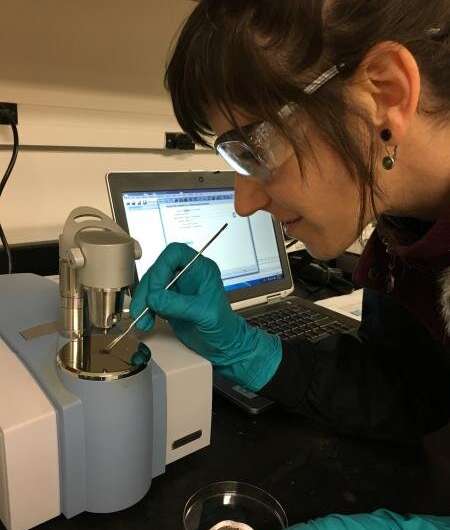Multiple lab analyses of Antarctic minerals offer a better understanding of Mars

Results of multiple and complementary lab analyses of minerals found in samples of material from Antarctica could give scientists a better understanding of the surface and subsurface environment of Mars, and indicate locations of potentially habitable subsurface locations, says a new paper by Planetary Science Institute Research Scientist Elizabeth C. Sklute.
Samples of intermittent brine discharge at Blood Falls at the terminus of Taylor Glacier, Antarctica were collected by Jill Mikucki of the University of Tennessee, Knoxville across two field seasons. The brine flows out from a subsurface body of water that has been isolated for possibly thousands of years. The brine flow deposits material that [is the] surface manifestation of a subsurface environment that hosts a thriving community of microbial life. Initially the brine is clear, but the deposits reddens with time on the surface, earning Blood Falls its name. These surface grab samples were tested at Sklute's lab using Fourier transform infrared, Raman, visible to near-infrared, and Mössbauer spectroscopies. Samples were further characterized using microprobe and inductively coupled plasma optical emission spectroscopy for chemistry, and X-ray diffraction, scanning electron microscopy, and transmission electron microscopy for mineralogy, crystallography, and chemistry.
"We took dry samples and we analyzed them by shining light of different wavelengths at them. Each wavelength of light makes the bonds and atoms in a sample react in a different way. Using them all together, it lets us figure out what is there," said Sklute, lead author of "A Multi-Technique Analysis of Surface Materials From Blood Falls, Antarctica" that appears in Frontiers in Astronomy and Space Science.
"We take each of these little pieces of information and we paste them together to form a whole image because one technique may be really good at telling you if certain things are there and another technique may completely miss it, simply because the bonds or atoms don't react to those energies," Sklute said. "These results showcase the strengths and weaknesses of different analytical methods and underscore the need for multiple complementary techniques to inform the complicated mineralogy at this locale.
"Combining these techniques, we have determined the detailed mineralogical assemblage of this Mars analog site and we have learned that the deposit is mostly carbonates and that the red color of Bloody Falls is from the oxidation of dissolved ferrous ions (Fe2+) as they are exposed to air, likely in combination with other ions. Instead of forming ferric (Fe3+) minerals, which is what usually happens on Earth, this brine turns into amorphous (no long range structure) nanospheres containing iron and a bunch of other elements, like chlorine and sodium. Amorphous materials have been found to be ubiquitous in Gale Crater on Mars by the Curiosity rover," Sklute said. "To date, we haven't been able to determine what the amorphous material on Mars is made of. Finding what may be similar material in a natural environment on Earth is really exciting.
"We do not say this is a biosignature because it is not produced by the microbes but rather by the chemistry where the microbes live. It does, however, give us a road map for a place to look on another frozen world," Sklute said.
"The method we have used in this study will also provide a powerful tool to help us understand how things can change with time if returned from another planet. It helps us understand the variability in phases that are really below the detection limit of most common techniques," Sklute said.
PSI Senior Scientist M. Darby Dyar is a co-author on the paper.
More information: Elizabeth C. Sklute et al, A Multi-Technique Analysis of Surface Materials From Blood Falls, Antarctica, Frontiers in Astronomy and Space Sciences (2022). DOI: 10.3389/fspas.2022.843174
Provided by Planetary Science Institute





















